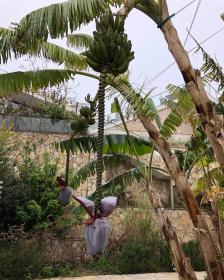Originally from the Far East, where they preceded the cultivation of rice and sugar cane, banana trees conquered Africa and then reached the Caribbean and Central America. They were only introduced to Europe very late in the 1920s and 1930s, at the very time when the beautiful dancer Josephine Baker caused a sensation in her show by entering the stage dressed simply in a loincloth decorated with bananas...
Today, bananas are grown in all tropical regions (Costa Rica, Cuba, Guinea, etc.) and are still in Madagascar. The word banana comes from an African port where the first specimens were imported... Although it exists in more than 100 different varieties, the species traditionally cultivated and found on our markets was nicknamed by the Latins (Pliny the Elder) "Fruit of the Wise" Musa sapientum, then at the time of the Crusaders "Apple of Paradise" Musa paradisiaca because of its possible role in "the story of Paradise lost."
Contrary to what one might think, the banana tree is not a tree but an herbaceous plant from a perennial underground bulbous stump that forms a pseudo trunk. Each plant produces fruit only once (after about a year) and dies shortly after while giving birth by budding to a young shoot that will perpetuate it.
The banana tree is both an ephemeral and eternal tree! What a paradox! It has a downward curved inflorescence axis in the shape of an ear bearing wonderful purplish-red to purple bracts resembling leaves under which are differentiated female flowers (which will give the fruits) and male flowers (which will be cut very quickly to avoid any fertilization).These flowers are rich in mucilages, a famous plant nectar appreciated for its softening and moisturizing cosmetic properties. They also have a high concentration of phytosterols and cyclopropene derivatives. It is, therefore, no coincidence that the Malagasy Pharmacopoeia recommends the decoction of flowers for treating burns and wounds and describes a notorious galactogenic effect.
